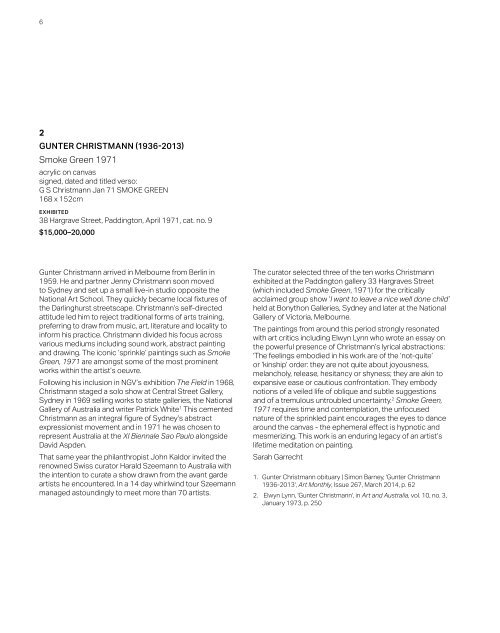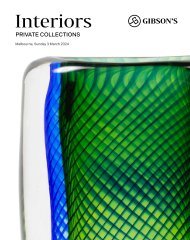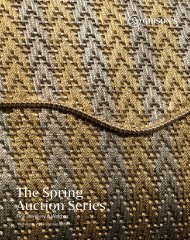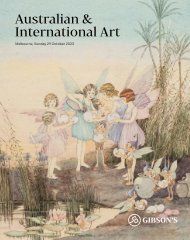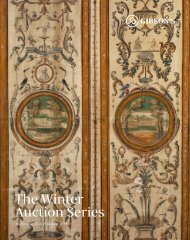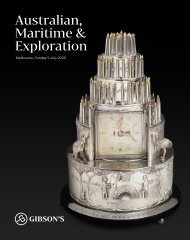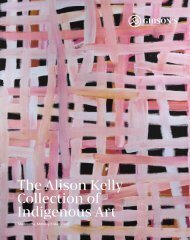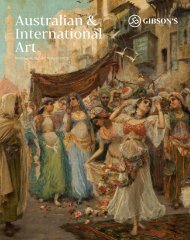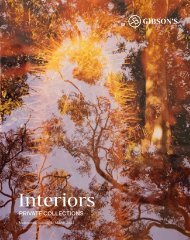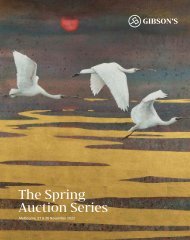GA039 | Australian & International Art
Create successful ePaper yourself
Turn your PDF publications into a flip-book with our unique Google optimized e-Paper software.
6<br />
2<br />
GUNTER CHRISTMANN (1936-2013)<br />
Smoke Green 1971<br />
acrylic on canvas<br />
signed, dated and titled verso:<br />
G S Christmann Jan 71 SMOKE GREEN<br />
168 x 152cm<br />
EXHIBITED<br />
38 Hargrave Street, Paddington, April 1971, cat. no. 9<br />
$15,000–20,000<br />
Gunter Christmann arrived in Melbourne from Berlin in<br />
1959. He and partner Jenny Christmann soon moved<br />
to Sydney and set up a small live-in studio opposite the<br />
National <strong>Art</strong> School. They quickly became local fixtures of<br />
the Darlinghurst streetscape. Christmann’s self-directed<br />
attitude led him to reject traditional forms of arts training,<br />
preferring to draw from music, art, literature and locality to<br />
inform his practice. Christmann divided his focus across<br />
various mediums including sound work, abstract painting<br />
and drawing. The iconic ‘sprinkle’ paintings such as Smoke<br />
Green, 1971 are amongst some of the most prominent<br />
works within the artist’s oeuvre.<br />
Following his inclusion in NGV’s exhibition The Field in 1968,<br />
Christmann staged a solo show at Central Street Gallery,<br />
Sydney in 1969 selling works to state galleries, the National<br />
Gallery of Australia and writer Patrick White 1 This cemented<br />
Christmann as an integral figure of Sydney’s abstract<br />
expressionist movement and in 1971 he was chosen to<br />
represent Australia at the XI Biennale Sao Paulo alongside<br />
David Aspden.<br />
That same year the philanthropist John Kaldor invited the<br />
renowned Swiss curator Harald Szeemann to Australia with<br />
the intention to curate a show drawn from the avant garde<br />
artists he encountered. In a 14 day whirlwind tour Szeemann<br />
managed astoundingly to meet more than 70 artists.<br />
The curator selected three of the ten works Christmann<br />
exhibited at the Paddington gallery 33 Hargraves Street<br />
(which included Smoke Green, 1971) for the critically<br />
acclaimed group show ‘I want to leave a nice well done child’<br />
held at Bonython Galleries, Sydney and later at the National<br />
Gallery of Victoria, Melbourne.<br />
The paintings from around this period strongly resonated<br />
with art critics including Elwyn Lynn who wrote an essay on<br />
the powerful presence of Christmann’s lyrical abstractions:<br />
‘The feelings embodied in his work are of the ‘not-quite’<br />
or ‘kinship’ order: they are not quite about joyousness,<br />
melancholy, release, hesitancy or shyness; they are akin to<br />
expansive ease or cautious confrontation. They embody<br />
notions of a veiled life of oblique and subtle suggestions<br />
and of a tremulous untroubled uncertainty. 2 Smoke Green,<br />
1971 requires time and contemplation, the unfocused<br />
nature of the sprinkled paint encourages the eyes to dance<br />
around the canvas - the ephemeral effect is hypnotic and<br />
mesmerizing. This work is an enduring legacy of an artist’s<br />
lifetime meditation on painting.<br />
Sarah Garrecht<br />
1. Gunter Christmann obituary | Simon Barney, 'Gunter Christmann<br />
1936-2013', <strong>Art</strong> Monthly, Issue 267, March 2014, p. 62<br />
2. Elwyn Lynn, 'Gunter Christmann', in <strong>Art</strong> and Australia, vol. 10, no. 3,<br />
January 1973, p. 250


